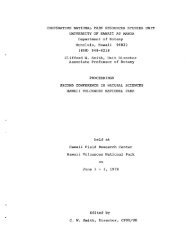american samoa - University of Hawaii at Manoa
american samoa - University of Hawaii at Manoa
american samoa - University of Hawaii at Manoa
Create successful ePaper yourself
Turn your PDF publications into a flip-book with our unique Google optimized e-Paper software.
introduced weeds, many <strong>of</strong> the Polynesian weeds have<br />
been severely reduced or have disappeared from<br />
American Samoa. Polynesian weeds reported on<br />
'Tutuila but not collected on the island in the last half<br />
century include Amaranthus viridus (Amaranthaccae),<br />
Cy<strong>at</strong>hula prostr<strong>at</strong>a (Amaranthaceae), Senna<br />
.sophc~rti (I:abaccae), and Urcrria lagopodoides<br />
(Pabaceae).<br />
The dominant weedy plants found on managed land<br />
are Mikania micrantha (mile-a-minute vine, fue<br />
saina), Nephrolepis hirsutula (sword fern, vao<br />
tuaniu), Bidens alba (beggar's-tick), and Paspalum<br />
conjug<strong>at</strong>um (T-grass, vao lima). Many other species<br />
may be common, depending upon soil, moisture, and<br />
type <strong>of</strong> management. About 250 species introduced<br />
species have become n<strong>at</strong>uralized in the archipelago<br />
(Whistler 1988b), and about 168 <strong>of</strong> these occur on<br />
Tutuila (Appendix A); most <strong>of</strong> these are weeds th<strong>at</strong><br />
thrive in sunny disturbed areas; most are flowering<br />
plants, but a few are ferns. Mikania, unlike the other<br />
three most abundant weed species, is a vine than can<br />
smother other herbaceous or shrubby veget<strong>at</strong>ion, and<br />
may inhibit timely regener<strong>at</strong>ion <strong>of</strong> forest from<br />
disturbed land.<br />
The dominant plants on the margins <strong>of</strong> the Alava<br />
Ridge road include Brachiaria mutica (California<br />
grass), Mikania micrantha, Calopogonium muco-<br />
noides, Mimosa pudica (sensitive plant, vao fefe), and<br />
Ludwigia actovalvis (primrose willow). There is very<br />
little if any current management, since the road is<br />
largely abandoned, so these are <strong>of</strong>ten mixed with<br />
shrubs and trees characteristic <strong>of</strong> secondary scrub.<br />
The roadway itself is domin<strong>at</strong>ed by a different set <strong>of</strong><br />
species th<strong>at</strong> do not thrive in the dense shade <strong>of</strong> the<br />
taller roadside plants; the most common plants here<br />
include Ludwigia octovalvis, Eleusine indica (goose<br />
grass, ta'<strong>at</strong>a'a), Cuphea carthagenensis, and Paspa-<br />
lum conjug<strong>at</strong>um. The roadsides from Afono to V<strong>at</strong>ia<br />
are domin<strong>at</strong>ed by weeds such as Desmodium tortuo-<br />
.sum (especially in places th<strong>at</strong> have not recently been<br />
sprayed or cut), Bidens alba, Paspalum conjug<strong>at</strong>um,<br />
and Calopogonium muconoides.<br />
lioadcuts are similar to cliffs in th<strong>at</strong> erosion on the<br />
steep surfaces prevents a stable climax veget<strong>at</strong>ion<br />
from becoming established. On the Alava Ridge road,<br />
the dominant species are weedy vines, such as<br />
Mikania micrantha and Dioscorea bulbifera (bitter<br />
yam, soi), secondary scrub species, such as Pipturus<br />
argenteus, secondary forest trees, such as Neonau-<br />
clea forsteri (afa), and ferns, such as Pneum<strong>at</strong>o-<br />
pteris glandulosa, Angiopteris evecta (king fern,<br />
nase), Pleisoneuron <strong>at</strong>tenu<strong>at</strong>um, and Macrothe-<br />
lyptris polypodioides. Also common is the large<br />
' n<strong>at</strong>ive reed Miscanthus floridulus (u). The road-<br />
cuts on the eastern part <strong>of</strong> the park are domin<strong>at</strong>ed<br />
mostly by secondary forest trees, such as Maca-<br />
ranga harveyana (lau p<strong>at</strong>a), Pipturus argenteus<br />
(soga), and Morinda citrijiolia (Indian mulberry,<br />
nonu), and herbaceous species such as Dioscorea<br />
bulbifera (bitter yam, soi), Mikania micrantha,<br />
Nephrolepis hirsutula (vao tuaniu), and Macro-<br />
thebpteris polypodoides. In some places Dicra-<br />
nopteris linearis (asaua, false staghorn fern) is<br />
dominant, especially on cliffs forming the edge <strong>of</strong><br />
the road.<br />
Other than the taro, coconut, and banana<br />
plant<strong>at</strong>ions around the fringes <strong>of</strong> the villages and<br />
along roads, there is hardly any current agricul-<br />
tural activity within the park boundaries. Only<br />
one person, a non-Samoan residing in V<strong>at</strong>ia, is<br />
currently known to have any inland plant<strong>at</strong>ions.<br />
One is on the hillside west <strong>of</strong> Amalau Valley,<br />
another is on Toa Ridge about halfway between<br />
the TV transmitter and the north coast, and another<br />
is reportedly on the ridge just to the west <strong>of</strong> Tafeu<br />
Bay. The Toa Ridge plant<strong>at</strong>ion is an area <strong>of</strong><br />
Dicranopteris linearis, which is suggestive <strong>of</strong><br />
ancient village or plant<strong>at</strong>ion sites. Currently only a<br />
few orange trees and a mango are planted there, all<br />
<strong>of</strong> them quite young. The area west <strong>of</strong> Tafeu Bay<br />
has some coconuts, possibly a remnant <strong>of</strong> former<br />
human activity (the name <strong>of</strong> the area is Nu'utoga,<br />
literally "Tongan village," which may indic<strong>at</strong>e its<br />
ancient st<strong>at</strong>us). The farmer using this area<br />
believes th<strong>at</strong> some <strong>of</strong> the trees there may be old<br />
cultiv<strong>at</strong>ed species th<strong>at</strong> he doesn't recognize, but<br />
unfortun<strong>at</strong>ely the area was not visited because <strong>of</strong><br />
we<strong>at</strong>her conditions.<br />
9. Secondary Scrub<br />
This is the type <strong>of</strong> disturbed veget<strong>at</strong>ion th<strong>at</strong> is<br />
domin<strong>at</strong>ed by shrubs and small trees. It is usually<br />
a successional stage between managed land, or<br />
land disturbed n<strong>at</strong>urally (as by a landslide), and<br />
secondary forest. The species th<strong>at</strong> domin<strong>at</strong>e here<br />
are mostly woody r<strong>at</strong>her than herbaceous. When<br />
the land is managed, or weeded in the case <strong>of</strong><br />
plant<strong>at</strong>ions, these woody plants are kept in check,
















